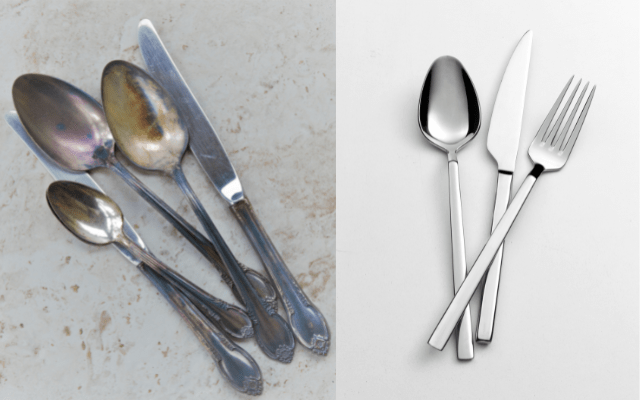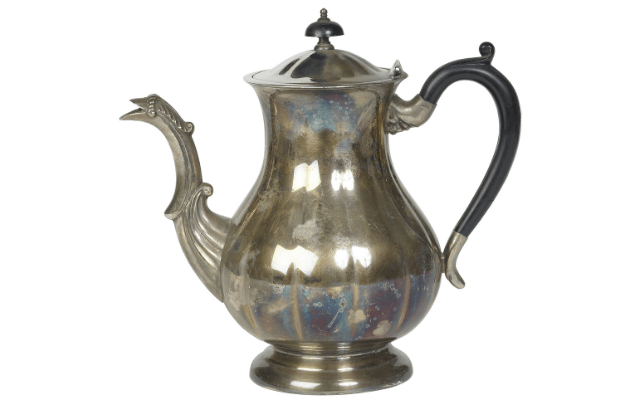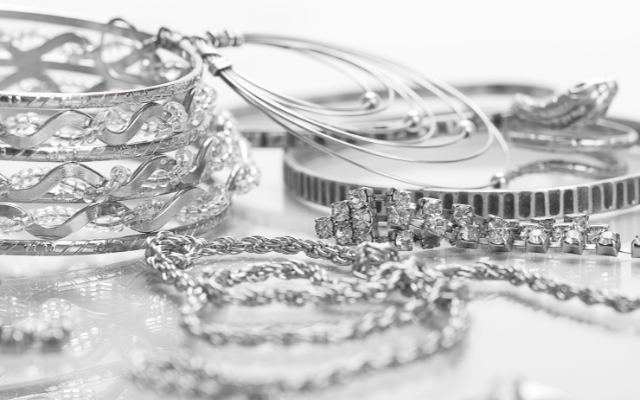Jump to: Does Silver Rust? | Rust vs Tarnish | Sterling Silver | How to Avoid Tarnish | How to Clean | Risks in Cleaning Silver | FAQs
Silver is a popular precious metal that has been used for centuries in the production of jewelry, decorative items, and even currency.
While many people are aware of the beauty and value of silver, they may not know much about its properties and how it reacts to the environment.
One common question that arises is whether or not silver rusts.
In this article, we will explore this question in detail and examine the factors that can cause silver to corrode or tarnish. We will also provide tips on how to prevent or remove tarnish from silver items and keep them looking their best for years to come.
Does Silver Rust?
In short, no. Silver does not rust. It tarnishes, which is a different type of oxidation. With the passing of time, these objects darken, losing their luster due to the oxidation of this metal by contact with oxygen and compounds containing sulfur.
The so-called sulfur compounds present in the air react with the silver to form silver sulfide (Ag2S). In the early stages of tarnishing, the color can change from yellow to red-blue. With the passage of time, the tarnish gets thicker and black, the true color of the silver sulfide.
What is the difference between rust and tarnish?

Rusted Iron Chain
Rust is an iron oxide, usually reddish brown. It is a chemical reaction between iron and atmospheric oxygen catalyzed by water. It happens with ferrous objects, and since it is a form of corrosion, the metal will deteriorate.
Even though both rust and tarnishing are corrosive chemical reactions, only rusting compromises the strength of the metal. Tarnish only affects the outer layer of silver, while the underlying metal will be intact in the silver jewelry, silver coins, or bars. The tarnish color will depend on the stage of the corrosion. It will go from yellow through red-brown to blue at the beginning of the tarnishing process and then turn black over time.

Tarnished Silverware vs “Clean” Silverware
Silver bullion does not lose value if tarnished. They are valued solely by their weight and metal purity, not their condition. Therefore, they can still be used for portfolio diversification.
However, to prevent your bullion from tarnishing, you must store it in sealed containers to prevent contact with air and also to avoid it in human areas once the humidity can accelerate the silver tarnishing.
Does Sterling Silver Rust?
No, sterling silver does not rust in the same way that iron and steel do.
Sterling silver is an alloy composed of 92.5% silver and 7.5% other metals, usually copper. While sterling silver may tarnish or corrode over time, it does not typically rust.
However, if sterling silver were alloyed with iron, it could potentially rust. Iron is highly susceptible to rusting, and if it were present in a sterling silver alloy, it could react with oxygen and moisture to form hydrated iron oxide or rust.
That being said, it is highly unlikely that sterling silver would be alloyed with iron, as the properties of iron are very different from those of silver and copper. Iron is a much harder and more brittle metal than silver or copper, and it would not be a good choice for an alloy intended for use in jewelry or other decorative items.
Does Sterling Silver Tarnish Faster than Pure Silver?
Compared to pure silver, sterling silver may tarnish faster due to the presence of these other metals. Copper, in particular, is known to react with air and other chemicals to form copper oxide, which can contribute to tarnishing.
However, the rate of tarnishing can vary depending on the specific composition of the sterling silver alloy and the conditions it is exposed to. Some sterling silver alloys may be more resistant to tarnishing than others, while factors such as humidity, air pollution, and exposure to chemicals can also affect the rate of tarnishing.
Silver Tarnish and How to Avoid It
The oxidation of silver is most often referred to as “tarnish.”
Tarnishing is the chemical process that happens when silver is exposed to sulfur-containing gasses in the air. It discolors and then darkens as it reacts with the gas to form a surface layer of tarnish.

In order to protect your coins or bars from tarnishing, here are some useful tips:
- Store them in a sealed container that limits exposure to air. And if possible, temperature-controlled storage, preferably a cool, dry place. There are capsules and special containers designed specifically to protect coins and bars.
- Handle them with gloves to avoid the salts and oils that are on the skin, mark the silver, and leave fingerprints.
- Avoid having silver items touching each other or household chemicals (including disinfectants, bleach, and even perfumes).
- Pure silver that is .999 fine can still tarnish. They are less likely to lose their shiny look as fast as sterling silver, but they are indeed prone to tarnishing.
There are some precautions you can take to prevent jewelry from tarnishing:

- Store your jewelry properly in storage bags or in a jewelry box for sterling silver that contains a protective inner lining to protect jewelry.
- Keep your jewelry dry inside the jewelry boxes.
- Jewelry Cleaning Machine is an ultrasonic cleaner machine that uses high-frequency sound waves to clean jewelry.
- Harsh chemicals such as colognes, perfumes, lotions, and body washes can also damage sterling silver jewelry.
- A dedicated silver polishing cloth is a great tool for cleaning sterling silver.
- The more alloy metal than silver the precious metal contains, the quicker it will tarnish, so invest in genuine, high-quality products.
- If wiping your jewelry down with a cloth doesn't remove dirt, fill up a cup with warm water and a couple of drops of mild dishwashing soap and wipe it down with a little soft brush.
- Even though hydrogen sulfide is already present in the air, avoid cooking food like onions and eggs around silver. They contain sulfur compounds, and when heated, these compounds can be released into the air and react with silver to form silver sulfide, which is responsible for tarnishing.
Check out our article on silver tarnish and how to avoid and clean it for a complete guide.
How to Clean Silver
Tarnish can be removed from silver mechanically with a polish, chemically with a dip, or electrochemically.
However, never clean numismatic coins or highly rare key date pieces. The following tips are only for common silver objects to be cleaned at home.
If your silver develops a tarnish, you can clean it using aluminum foil and fill it with warm water. Add two teaspoons of baking soda and one teaspoon of salt. Immerse your jewelry in this solution for a few minutes, and then you can wash the mix from the pieces and then dry it.
Watch the following video for further tips on how to clean silver coins:
Risks in Cleaning Silver
There are cases where a homemade cleaning solution may not solve the problem.
For example, if your silver jewelry or bullion shows a green color, that could mean that the copper content has corroded. In this case, the best bet to not harm your silver is to have the help of a professional to get the proper care.
Silver is a soft metal and can be easily damaged if not handled carefully and if you don't use a soft cloth when polishing it. Scrubbing it will eventually wear off any markings or images on the silver.
For numismatic coins, some collectors would expect an old coin to look worn and to have some antique coloration.
It is important you don't let silver sit in any homemade cleaning solution for too long, as it could potentially damage the silver itself. However, most solutions made specifically for cleaning silver will not harm silver in any way.
Looking for tips on how to clean silver bars? Check out our article.
FAQs
How long does it take for silver to rust?
Silver does not rust. But conditions like exposure to air, humidity, and human fluids can accelerate the tarnishing process, which will only change the superficial layer of the metal. The process can take a few years, but if exposed to air, it can take only a few months.
Does silver rust in water?
Pure silver does not rust. Specifically, sterling silver reacts to a mixture of hydrogen sulfide and oxygen in the air, But water can accelerate the oxidation process that will tarnish the silver. Rust affects only ferrous metals. Copper, silver, aluminum.
Does sterling silver get rusty?
Sterling silver does not rust. It tarnishes. Rust is a corrosion on iron objects when it reacts with oxygen through water. Tarnished silver is a silver that was exposed to air, which contains sulfur-containing gas, and the oxidation caused by that will just form a dark layer on the surface of the silver.
What is the difference between silver tarnish and silver rust?
Rust tends to be reddish in color and happens to iron. It also deteriorates more layers of the metal; tarnish is oxidation that happens due to sulfur in the air and the silver. it leaves a dark, antique aspect on most layers of the silver without compromising the quality of the silver inside.
















